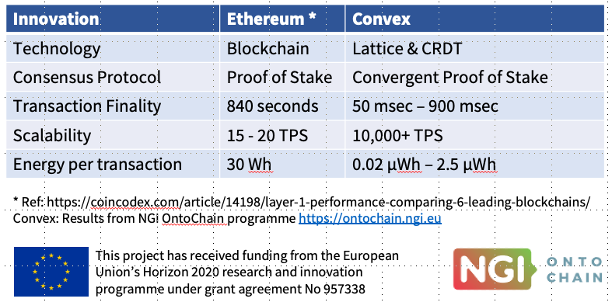The Convex network introduces a different approach to decentralized technology. It combines a lattice-based structure with Conflict-Free Replicated Data Types (CRDTs), diverging from the usual blockchain model. This structure is of particular interest to developers in the Clojure community, offering a new way of building decentralized applications (dApps).
First Look at the Convex Decentralized Network from a Developer's Perspective
Convex is an innovative blockchain that has multiple interesting aspects. Its main advantages are Convex lisp and lattice-based structure merged with Conflict-Free Replicated Data Types. This provides an interesting new solution for the Internet of Value and smart contracts.
Functioning as a decentralized network and execution engine, Convex could be viewed as a variant of a “Stateful Internet,” where the network hosts and securely executes code and data. This design positions Convex as a full-stack solution for decentralized applications and programmable economic systems, particularly those focused on digital asset management.
Mission and Vision:
Convex presents itself as a platform aimed at fostering open and fair digital economic systems, a goal that might resonate well with the Clojure community, known for its preference for innovative and ethical tech solutions. The platform sets itself apart from some of the more controversial aspects often associated with blockchain technologies, seeking to offer a more positive and constructive contribution to the digital economy.
However, as with any emerging technology, potential users and developers should consider the platform’s maturity, community support, and real-world application cases to gauge its suitability for their specific needs.
Convex and Clojure: A Seamless Integration
At the heart of Convex is Convex Lisp, a dialect that resonates deeply with Clojure. This alignment is more than just syntactical; it’s philosophical, embracing immutability and functional programming as core tenets. For Clojure developers, this means leveraging a familiar environment for developing smart contracts and dApps, while enjoying the benefits of a decentralized, secure, and scalable platform. Convex Lisp’s design is all about using unchanging data structures and functions that don’t hold onto any state. This approach makes it a powerful tool for crafting decentralized applications that are not only sturdy but also secure.
Innovative Features and Developer Tools
Convex is famous for its suite of advanced features:
– Lisp for Actors (Smart Contracts): Lisp’s built-in support for symbolic computation and its macro system allows the creation of advanced abstractions and code manipulation as data. It enhances the ability to create functionalities that are not only highly customizable but also adaptive to various needs. This makes it an excellent choice for the complex and evolving needs of decentralized applications and smart contracts.
– On-Chain Compiler: An innovative feature that allows real-time code compilation and deployment directly on the blockchain. This enhances flexibility and cuts down on development time.
– Dynamic `eval` in Actors (Smart Contracts): With this feature, scripts can be executed on-the-fly within smart contracts, paving the way for complex and adaptive contract functionalities.
– Lattice Technology and CRDTs: These form the backbone of the Convex’s data structure. It ensures efficient data synchronization and conflict resolution across its distributed network, which is a critical aspect for maintaining consistency in a decentralized environment.
Comparative Analysis: Convex's Lattice vs. Traditional Blockchain
The lattice structure of Convex represents a significant deviation from conventional blockchain architecture:
– Structure and Data Organization: Unlike the linear chain of blocks in traditional blockchains, Convex’s lattice structure offers more efficient data organization and access, potentially leading to improved scalability and faster transaction processing.
– Consensus Mechanism: Convex’s Convergent Proof of Stake (CPoS) consensus mechanism, designed specifically for its lattice structure, prioritizes efficiency and scalability. This stands in sharp contrast to the typically resource-intensive Proof of Work (PoW) or Proof of Stake (PoS) mechanisms found in traditional blockchains.
Empirical Performance: Convex vs. Ethereum
In the [NGi OntoChain study,]Convex’s performance was analyzed with a focus on various metrics, revealing its significant advantages over Ethereum:
– Transaction Confirmation Latency: Convex significantly shortens transaction confirmation times, a crucial factor for enhancing user experience. This rapid response and interaction within the network make it exceptionally well-suited for applications demanding immediate transaction processing.
– Scalability and Transaction Throughput: Convex is designed to efficiently handle a range of transaction types, with a particular focus on complex transactions like AMM trades. Positioned for global-scale usage, compared to systems like VISA, averaging around 2000 transactions per second (TPS), Convex has demonstrated even higher TPS in lab tests (10,000+). However, the primary focus lies in its capability to efficiently handle complex transactions.
– Energy Efficiency: The study also highlighted Convex’s lower energy consumption per transaction. This feature aligns with the increasing global focus on sustainable technology solutions, making Convex an environmentally conscious choice in the blockchain space. It’s important to highlight the fluctuation in transaction throughput, which depends on the transaction type. Convex excels in managing more intricate and demanding transactions, adding a layer of complexity when making direct comparisons with other networks. This makes direct comparisons with other networks challenging, as definitions of “transaction” vary across different blockchain platforms.

It’s worth emphasizing that transaction throughput can vary significantly depending on the nature of transactions. Convex excels in effectively managing more complex transactions. It’s advisable to approach results with caution, considering these tests are conducted in a controlled lab environment and may not fully reflect the performance of the live network.
Leveraging convex.cljc for Enhanced Clojure Integration
The convex.cljc library is an important tool in Convex’s toolkit, enabling Clojure developers to seamlessly engage with the Convex network directly from their familiar development environment. This integration facilitates:
- Direct Network Interaction: Clojure systems seamlessly connect and interact with the Convex network, enabling developers to effortlessly query, transact, and manage contracts. This integration also offers the capability to run network peers, allowing the setup of local testnets programmatically or the control of your peer running on the mainnet directly from your Clojure environment.
- Smart Contract Management: Utilizing REPL, developers can write, deploy, and test smart contracts in real time, streamlining the development process.
- Dynamic Development Experience: The library enhances the REPL-driven development approach, allowing for instantaneous feedback and iterative development, which is crucial in a fast-paced decentralized application landscape
The Virtues of Functional Programming in Smart Contract Development
The functional programming paradigm, central to Convex Lisp, is crucial in enhancing the security and reliability of smart contract development. By focusing on immutability and stateless functions, Convex provides a robust foundation for building decentralized applications:
- Immutable State: Ensures that once the data is written to the blockchain, it remains unaltered. This fosters a sense of trust and integrity in transactions and contracts.
- Predictable Function Execution: Stateless functions enable consistent and reliable behavior. This is vital for the deterministic nature of smart contracts.
- Enhanced Security and Reliability in Contract Logic: The use of pure functions, where the output is solely determined by the input, eliminates side effects and provides a heightened level of security. This is particularly crucial for financial and contractual transactions on the blockchain.
- Program Verification: The functional programming paradigm facilitates formal verification of code, a critical aspect for smart contracts, where security and reliability are paramount.
Network’s timeline
The upcoming launch of Convex’s Protonet, scheduled for the first quarter of the year, marks a significant milestone in the development of the Convex network. This inaugural live version is set to introduce a range of advanced features, featuring a powerful on-chain compiler, the Taurus decentralized exchange, and sophisticated smart contract capabilities.
Protonet’s design intricately balances robust security measures with innovative tokenization methods for both real-world assets and transactional use. The incorporation of memory accounting and a consensus-based stake requirement further strengthens the network’s security framework, indicating Convex’s dedication to establishing a secure, versatile, and decentralized ecosystem.
After the launch of Protonet, Convex’s future objectives in its project timeline are expected to include expanding its decentralized ecosystem with improved functionalities and broader applications. This phase is likely to prioritize the refinement of security features, the scaling of network capabilities, and the integration of more complex economic systems.
Additionally, there may be efforts to foster community engagement and collaboration, enhancing the ecosystem’s robustness and versatility. The Convex team might also explore innovative ways to utilize digital assets and smart contracts, further pushing the boundaries of decentralized technology.
Key use cases for Convex
Dynamic Governance in DAOs: Leveraging Convex Lisp’s dynamic eval feature, Convex introduces a distinctive capability to dynamically update smart contract logic. This is made possible through its on-chain compiler and Lisp’s inherent flexibility, revolutionizing DAO governance. This adaptability enables the real-time evolution of governance protocols, representing a significant improvement over the static nature of contracts in EVM-based chains where updates are cumbersome and time-consuming.
Real-Time Multiplayer Gaming: Convex is ideal for creating blockchain-based multiplayer games. Unlike traditional blockchains, Convex can efficiently process and update complex game states on-chain, offering a seamless gaming experience. This is exemplified by a Minecraft-like voxel game, where entire game worlds are managed on-chain. This showcases a level of interactivity and real-time updates that are not feasible on EVM-based chains.
Interactive Decentralized Applications (dApps): The low-latency interaction provided by Convex’s architecture is essential for decentralized applications (dApps) that demand immediate user feedback, such as social networks or live trading platforms. This capability is rooted in the efficient data synchronization enabled by lattice technology and Conflict-free Replicated Data Types (CRDTs), which traditional blockchains with higher latency and slower transaction times often find challenging to achieve.
Economically Sustainable Models: The platform’s low transaction costs and scalability, enabled by its lattice structure and efficient consensus mechanism (CPoS), make Convex well-suited for applications where economic sustainability is key. This is especially relevant for systems like micropayment channels or decentralized marketplaces and prediction markets, where the high costs and limited scalability of traditional blockchain platforms pose significant obstacles.
Conclusion
Convex, with its lattice technology, integration with Clojure, and focus on functional programming, stands as a pioneering platform in the decentralized world. It offers developers not only a new technology but a new philosophy for building secure, efficient, and scalable decentralized applications.
For a comprehensive exploration of Convex’s capabilities and detailed performance metrics, the full study by NGi OntoChain and additional resources provide an in-depth understanding of this innovative platform.
Resources
- Main Website You can find the whitepaper here.
- Convex Foundation’s YouTube Channel You can participate in the weekly live meet and ask questions, or catch up on their recordings. Also includes various demos, sessions, and short talks about various related topics.
- Convex Foundation’s Github Organization Here you can find different resources like design document, logseq knowledge base, and source code for projects and tools.
Talks in popular Clojure conferences about Convex









